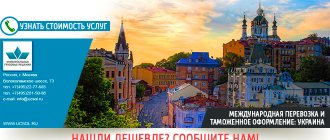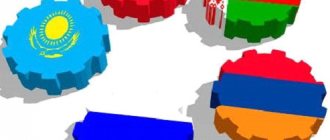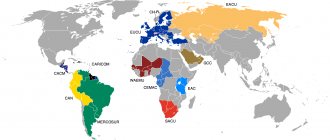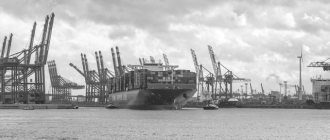The Russian government has expanded economic sanctions against Ukraine, adding to the list of goods prohibited for import, including some food products. Their full list is disclosed in the relevant resolution posted on the official Internet portal of legal information.
Thus, the Russian government has added to the list of products that are prohibited from being imported from Ukraine by decree of December 29, 2021. This decision was made in accordance with the presidential decree of October 22, 2021 “On the application of special economic measures in connection with unfriendly measures of Ukraine against citizens and legal entities of the Russian Federation.”
Legal grounds
Ukraine began to impose sanctions against Russia in the spring of 2014 in connection with the reunification of Crimea with the Russian Federation, as well as the outbreak of the conflict in Donbass. The basis for them was the law “On Sanctions” signed on September 10, 2014 by Ukrainian President Petro Poroshenko.
The document provides for the possibility of introducing restrictive measures against the Russian Federation: more than 20 types of sanctions, including stopping the transit of energy resources. The law came into force on September 12, 2014, and was last amended on December 17, 2021.
According to the document, sanctions can be applied in order to “protect national interests, national security, sovereignty and territorial integrity of Ukraine, counter terrorist activities, as well as prevent violations and restore violated rights, freedoms and legitimate interests of citizens of Ukraine, society and the state.”
The decision to apply sanctions is made by the National Security and Defense Council (NSDC) of Ukraine, its decision is put into effect by decree of the head of state.
Certification of products from Ukraine
Our company provides services in obtaining all the necessary permits necessary for processing imports to Russia, as well as obtaining “general form” certificates of origin for Russian goods for export to Ukraine (ST-1 was issued before leaving the agreement on the creation of the CIS). A big advantage is the fact that our company structure includes its own product certification body.
At your request, we will insure your cargo for the entire duration of its transportation.
Benefits of working with us
- We work 7 days a week 365 days a year
- Highly qualified specialists with extensive experience
- We bear full responsibility for the clearance of goods at customs
- We process any goods at any customs in Russia
Trade sanctions
On December 29, 2015, President of Ukraine Petro Poroshenko signed changes to the law “On Foreign Economic Activity” (adopted by the Rada on December 24, 2015), which allows the government to impose economic sanctions against Russia in response to the Russian pro-dembargo and the cancellation of the free trade agreement with respect to Ukraine . On December 30, a list of Russian goods prohibited for import into the country was approved. It included bakery, flour confectionery products, chocolates, meat, fish, coffee, tea, baby food and more (43 items in total).
On January 1, 2021, in connection with the entry into force of the economic part of the association agreement between Ukraine and the European Union, Russia, in order to protect its economic interests, suspended the free trade agreement (FTA) with Ukraine. In addition, from the beginning of 2021, the food embargo imposed by the Russian government in response to European sanctions against Russia, in force since August 2014, has extended to Ukraine. The import of Ukrainian meat, sausages, fish and seafood, vegetables, fruits, and dairy products was banned. .
In response to these decisions of the Russian authorities, Ukraine adopted a resolution “On the ban on the import into the customs territory of goods originating from Russia” (came into force on January 10, 2021). The sanctions list, in particular, includes meat and meat products, fish, dairy products, processed cheeses, coffee, tea, grain, confectionery, baby food, railway equipment and other items (more than 30 types of goods in total). Subsequently, Kyiv periodically expanded sanctions restrictions on Russian goods. In March 2021, a temporary ban was introduced on the import of all mineral fertilizers from Russia. In December 2021, trade restrictions against the Russian Federation were extended until 2021.
On April 10, 2021, the Ukrainian government expanded trade sanctions against the Russian Federation. According to the Ministry of Economic Development and Trade of Ukraine, the imposed embargo applies to formaldehyde and urea-formaldehyde concentrate, springs for freight cars, electrical equipment for railway automation and communications devices, as well as electrical conductors for voltages over 1000V. In addition, imports from the Russian Federation of glass containers, including cans, bottles for food and beverages, containers, etc., were subject to sanctions.
On May 15, 2021, the Ukrainian government introduced new economic sanctions against Russia, including a ban on the supply of certain groups of goods and the introduction of special duties. The ban applies to certain types of “industrial goods, mineral fertilizers, agricultural products, vehicles, plywood and others.” By the second decision, the Cabinet of Ministers of Ukraine introduced special duties on the import of certain goods from the Russian Federation from August 1, 2021. Their size will be determined by a “percentage of the customs value.”
On June 26, 2021, it became known that from August 1, the Ukrainian government banned the import of Russian-made cars, buses, tractors, trucks and motorcycles into the country. In addition, from March 1, 2021, it will be prohibited to import used railway and tram cars from Russia to Ukraine. The list of trade restrictions also includes raw materials for the production of cement, all finished types of finished cement, mineral (nitrogen, potassium and phosphorus) fertilizers, animal feed and veterinary medicine products. The embargo will affect matches, plywood products, wallpaper, light industrial products, shoes, wires, pipes, metal mesh, fasteners, steel utensils, and baking equipment.
What is Ukraine doing
At the end of March, Kyiv once again tightened sanctions against Russia, banning the import of wheat, rye and sunflower oil from the country. Also, the list of goods prohibited for import to Ukraine has been supplemented with newspaper and toilet paper, kraft paper, cosmetic wipes, hand towels, tablecloths, detergents, boxes, boxes, bags, packages, drilling tools, wheels and their parts, and others.
At the same time, from February 1, Ukraine, against the backdrop of a coal shortage, resumed purchasing electricity from Russia. Then acting Energy Minister Yuri Vitrenko called the deal inevitable, since the republic is still in the common energy system with Russia and Belarus. According to him, to avoid procurement, Ukraine must connect to Europe. Before this, Deputy Energy Minister Vitaly Shubin indicated that the process would take about three years.
Trade turnover
According to the Federal Customs Service of Russia, trade turnover between the two countries at the end of 2013 amounted to $39 billion 604 million. After the coup in Ukraine in February 2014, the volume of mutual trade between the countries began to decline, decreasing by almost four times by 2021. In 2014 it amounted to $27 billion 811 million, in 2015 - $14 billion 966 million, in 2021 - $10 billion 234 million. However, in the last two years there has been an increase in Russian-Ukrainian trade turnover: in 2021 - $12 billion 855 million, in 2021 - 14 billion 984 million.
The government has approved a list of goods prohibited for export from the Russian Federation to the territory of Ukraine
The Russian government has amended Decree No. 1716-83 dated December 29, 2021. This document introduced a ban on the import into Russia
Goods whose country of origin is Ukraine, Goods or goods transported through the territory of Ukraine.
By Resolution No. 460-25 of April 18, 2021, Russian officials introduced a ban on the export of a number of goods to Ukraine.
“A few days ago, the Cabinet of Ministers of Ukraine took another unfriendly step towards our country - it expanded the list of Russian goods prohibited for import into Ukraine. In these conditions, we are forced to defend our interests and take retaliatory measures.”
Prime Minister Dmitry Medvedev Import: the list of goods prohibited for import into Russia has been expanded
“This measure will affect Ukrainian mechanical engineering, light industry, and metalworking products, the value of which last year amounted to almost $250 million.”
Prime Minister Dmitry Medvedev
Uncoated paper and paperboard, of a kind used for writing, printing or other graphic purposes, and unperforated cards and unperforated paper strips, in rolls or rectangular (including square) sheets of any size, other than paper of heading 48.01 or 48.03; handmade paper and cardboard
Kraft paper and kraft paperboard, uncoated, in rolls or sheets, other than those of heading 48.02 or 48.03
Paper and paperboard, laminated (made by gluing together flat layers of paper or paperboard with an adhesive), without surface coating or impregnation, reinforced or unreinforced, in rolls or sheets
Paper and paperboard, corrugated (whether or not covered with a plain outer sheet), creped, embossed or perforated, in rolls or sheets, other than those of heading 48.03
Cardboards, boxes, boxes, bags, bags and other packaging containers, made of paper, cardboard, cellulose wadding or cellulose fiber cloth; filing boxes, letter trays and the like, of paper or paperboard, of a kind used in offices, shops or similar purposes
Suits, sets, jackets, blazers, dresses, skirts, culottes, trousers, overalls with bibs and straps, breeches and shorts (except swimwear), knitted by machine or hand knitting, for women or girls
T-shirts, sweatshirts with sleeves and other body sweatshirts, knitted or crocheted Sweaters, pullovers, cardigans, vests and similar knitted products, knitted or crocheted
Tights, stockings, stockings, socks and underwear and other hosiery, including compression hosiery with distributed pressure (for example, stockings for those suffering from varicose veins) and shoes without soles, knitted or crocheted
Suits, sets, jackets, blazers, dresses, skirts, culottes, trousers, overalls with bibs and straps, breeches and shorts (except swimwear) for women or girls
Bras, belts, corsets, suspenders, garters and similar articles and parts thereof, knitted or crocheted or not knitted Other footwear with soles and uppers of rubber or plastics
Shoes with soles made of rubber, plastic, natural or composite leather and uppers made of genuine leather
Shoe parts (including shoe upper blanks with an attached or unattached main insole); insoles, heel pads and similar products; gaiters, gaiters and similar articles, and parts thereof
- List of Products Prohibited Import into Russia from Ukraine
- List of Prohibited Products from Ukraine to Russia
- List of Goods Prohibited for Import to Ukraine from Russia
- List of Prohibited Goods from Ukraine to Russia
- Goods Prohibited for Export from Ukraine to Russia
- What is Prohibited from Delivering to Russia from Ukraine
- Russian bans on the import of products from Ukraine
List of Goods That Are Prohibited for Export from Ukraine to Russia
List of goods prohibited for import into Russia from Ukraine and Russian goods prohibited for export to Ukraine
Having its own representative office in Ukraine (Ivanofrankovsk), our company will ensure the delivery of any cargo weighing from 1 ton from Ukraine to Russia, the CIS countries and the EAEU. Allow the movement of goods specified in paragraph 1 of this resolution through the territory of the Russian Federation to third countries in accordance with the customs procedure of customs transit, provided that traceability of their transportation is ensured and applied to cargo spaces (compartments) of vehicles and railway rolling stock, premises, containers and other places in which goods are or may be located, identification means (seals), including those operating on the basis of the technology of the global navigation satellite system GLONASS.
* For the purposes of applying this list, you should be guided solely by the EAEU HS code; the name of the product is given for ease of use.
In pursuance of subparagraph “c” of paragraph 2 of Decree of the President of the Russian Federation of October 22, 2021 No. 592 “On the application of special economic measures in connection with unfriendly actions of Ukraine against citizens and legal entities of the Russian Federation,” the Government of the Russian Federation decides:
* For the purposes of applying this list, you should be guided solely by the EAEU HS code; the name of the product is given for ease of use.
The government has approved a list of goods prohibited for export from the Russian Federation to the territory of Ukraine
The Russian government has amended Decree No. 1716-83 dated December 29, 2021. This document introduced a ban on the import into Russia of: Cardboard boxes, boxes, bags, bags and other packaging containers made of paper, cardboard, cellulose wadding or cellulose fiber cloth; filing cabinets, letter trays and the like, of paper or paperboard, of a kind used in offices, shops or similar purposes Bras, girdles, corsets, suspenders, garters and the like and parts thereof, whether knitted or crocheted or not knitted" A few days ago The Cabinet of Ministers of Ukraine took another unfriendly step towards our country - it expanded the list of Russian goods prohibited for import into the territory of Ukraine. In these conditions, we are forced to defend our interests and take retaliatory measures.”
Suits, sets, jackets, blazers, dresses, skirts, culottes, trousers, overalls with bibs and straps, breeches and shorts (except swimwear), knitted by machine or hand knitting, for women or girls
What can and cannot be imported into Russia from Ukraine in 2019: lists of prohibited and permitted products
What can a tourist bring to Russia from Ukraine? Customs rules from January 1, 2021 reduce the limit on the number of goods exempt from duties. The nuances depend on what transport you prefer:
- vegetables and fruits;
- greenery;
- nuts;
- confectionery;
- chocolate;
- alcoholic drinks from, "Obolon", "Chernigovskoe" and "Shustov";
- juices and baby food;
- potato;
- seeds;
- jams;
- planting material;
- canned vegetables and fish;
- dairy products;
- pork;
- cheeses;
- fish and crustaceans;
- food gelatin;
- mayonnaise;
- powdered milk;
- Bee Honey;
- soybeans, sunflower seeds and soybean meal.
The export of cultural property from the territory of Ukraine without a preliminary declaration and expert opinion, on the basis of which a permit to cross the border is issued, is also prohibited. Souvenirs that you bought in a store can be transported without restrictions, as well as objects of modern painting, sculpture, etc. This includes works purchased in a retail chain after 1950, and books published after 1945. Please check in advance whether the limits have been exceeded: otherwise you will have to pay an additional 30% of the cost of the items ( at least 4 € per kg ).
Do not evade compliance with the laws: violations are fraught with a fine in the amount of twice the value of the item and confiscation. When you carry food and belongings, do not pack them in many bags, especially opaque ones. During security at the airport or train, you will be forced to remove the contents. The more supplies you have wrapped in bags, the more attention you will attract from customs officials. And the use of opaque packaging is almost guaranteed to lead to a thorough search.
Read about Russian-Ukrainian relations:
- How to Deliver Spare Parts from Ukraine to Russia
- How to Send a Gift to Ukraine from Russia
- What are the Documents for Residence in Russia for a Citizen of Ukraine?
- We call from Roaming in Ukraine to Russia
- Program for the Resettlement of Compatriots to Russia from Ukraine Website
Attention!
Due to recent changes in legislation, the legal information in this article may be out of date! Our lawyer can advise you free of charge - write your question in the form below.
What Moscow banned
Among the food products on the list were wheat, sunflower oil, prepared or canned fish, sturgeon caviar, confectionery, chocolate, bread, canned vegetables and fruits, fruit and vegetable juices, beer and wine.
Industrial products include pebbles, gravel, crushed stone, detergents, paper and cardboard, wallpaper, furniture with built-in refrigeration or freezing equipment, wires and cables, tractors and trailers, as well as feminine sanitary pads and tampons, baby diapers and nappies.
Strana has already published a complete list of prohibited goods.
The main thing that catches your eye is that the list contains almost no main Ukrainian export products that are sold to Russia. These are inorganic chemical products (16.5% of the total volume), ferrous metals (20.4%), as well as reactors, nuclear boilers and machines (14.4%).
It seems that they decided to make some kind of hint to Ukraine. But to deliver a serious blow was not the goal. Bye.
The agricultural nature of the sanctions is also noteworthy. Most of the list is occupied by finished products and agricultural raw materials for them.
Interestingly, in 2021, agricultural and food exports from Ukraine to Russia grew the fastest. According to the Federal Customs Service, since the beginning of 2021, Ukraine has increased exports of products of animal origin to the Russian Federation by 292%, and of plant origin by 289%. That is, the fastest growing exports were banned.
By the way, almost all deliveries of confectionery products to Petro Poroshenko, who was spared by previous sanctions, were banned (more on that below).
Of course, his chocolate has not been sold directly to Russia for a long time - this is harmful to the president’s image. However, nothing prevented any intermediary company from purchasing Roshen products and selling them in the Russian Federation (Poroshenko’s company itself can do this secretly). Now this path will be closed.
Candy is a completely different story. Recently, Ukraine introduced a ban on the supply of starch and molasses from Russia. The authors of the innovation complained that over the past year our confectioners have greatly increased the supply of these products from the Russian Federation. A mirror situation emerges: first we banned Russian raw materials for candies, and then they banned our candies from the same raw materials.
A separate point is the ban on the import of certain types of turbines. In Ukraine, they are mainly produced by Kharkov-based Turboatom, one of the most profitable state-owned enterprises. Thus, the vector of pressure on the budget-forming sector of the Ukrainian economy is visible.
Another important aspect is the blow to Ukrainian winemaking. Russia accounts for half of Ukraine’s wine exports – 15 million dollars out of 31 (data for 2021). This means that industry revenues will drop significantly.
At the same time, it is noticeable that the list was compiled in such a way as not to hit the Russian economy. The same turbines for civil aviation can be imported. It’s funny that sturgeon is on the stop list – which Russia itself supplies to the world market in large quantities. In Ukraine, their catch is minimal - and, of course, it is clearly not enough for any significant export to the Russian Federation. On the contrary, Ukraine imports the same caviar from Russia.
It’s a similar story with wheat – in less than a full year of 2021, grain was imported from Ukraine to Russia for a meager $20 million.
Measures to counter re-exports are also visible. By the way, they may also concern the same sturgeon or the mollusks indicated in the list. As for, for example, pads and diapers, Ukraine does not produce them at all - foreign companies are in the lead here, whose production facilities are located mainly in Eastern Europe - Poland and the Czech Republic, as well as Turkey.
However, despite the selectivity of the list, the damage to Kyiv could be serious.
How will the ban affect the economies of Ukraine and Russia?
According to data for 2021, the volume of Ukrainian exports to the Russian Federation amounted to almost 5 billion US dollars. Of these, 10% are goods included in the sanctions list. According to the Russian Ministry of Economic Development, the value of the prohibited products is about 470 million US dollars.
In turn, the cost of exporting Russian goods to the territory of Independence is 8 billion US dollars, most of which are products from the energy sector, including fuels and lubricants.
However, if Russia has the opportunity to supply goods prohibited for import into Ukrainian territory to other countries or redirect them to its domestic market, then Ukraine is deprived of such a chance. This is due to the low purchasing power of the population, which continues to fall every year. At the same time, goods produced in Ukraine are not in demand in the EU markets, and therefore their supplies are limited by quotas provided by the European Union. The quotas themselves are so small that within a couple of months they are completely exhausted. And this means only one thing - hundreds of companies in Ukraine will be forced to close, which will lead to an increase in the unemployment rate in the country and provoke a further decline in the economy.
In the context of the current restrictive measures, the ordinary working population of Square has only one option left - to hope that Kyiv and Moscow will be able to come to an agreement and resolve the situation by at least partially lifting the sanctions imposed on each other.





